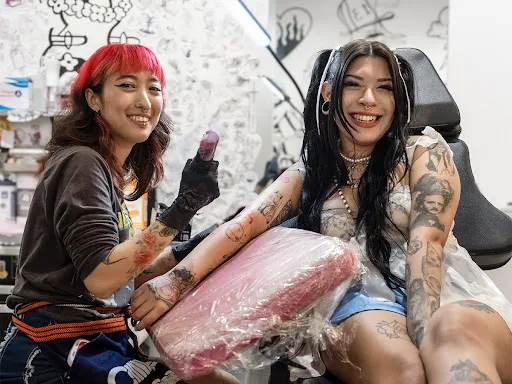Celebrating Friday the 13th: Live By The Sword Tattoo’s Commemorative Event
As the clock strikes midnight on the very early morning of Friday the 13th, tattoo enthusiasts and curious spectators alike gather around Live By The Sword Tattoo in New York City, the beating heart of a tradition that spans decades. Every year on this day, tattoo shops across the country open their doors to those seeking to embrace, rather than fear, their superstitions. Live By The Sword Tattoo has made its mark by transforming what was once regarded as a day of bad luck into a jubilant celebration of body art and self-expression.
NYC’s Official Tattoo Holiday
In the bustling streets of New York City, the significance of Friday the 13th has transcended its infamous reputation. For tattoo lovers, it has become an unofficial holiday, a time when artists offer tattoos at discounted rates, with specific designs that celebrate the day itself. Live By The Sword Tattoo has gained notoriety for its Friday the 13th events, attracting both seasoned tattoo enthusiasts and first-timers alike.
“It’s a unique way to celebrate a day that typically receives a bad rap,” co-owner of Live By The Sword Tattoo explains. “We want everyone to feel welcomed and to challenge the negative connotations associated with the date.” This year, the studio expects record numbers as it continues to uphold the tradition of making Friday the 13th a day of vibrant celebration.
The Tattoo & Piercing Event
On this special day, tattoo shops typically offer a flash sale where customers can choose from predetermined designs that hold special meaning related to Friday the 13th. At Live By The Sword Tattoo, artists have collaborated to create a unique set of small tattoos, each representing different aspects of luck, misfortune, and various interpretations of superstition. These can range from classic symbols like keys, black cats, and horseshoes to abstract designs that resonate with personal experiences.
The event at Live By The Sword Tattoo has attracted many visitors, with lines forming long before the doors open. Each tattoo tells a story—a means of claiming power and breaking free from the hold that superstition has had on an entire generation. From a traditional skull and crossbones to contemporary minimalist designs, every piece crafted on this special date reinforces a sense of community among those who dare to embrace the unconventional.
Is Friday the 13th Really Unlucky?
The question looms large: is Friday the 13th truly an unlucky day? The origins of the superstition are murky, with various theories tracing back centuries. Some scholars suggest that the fear of the number 13, known as triskaidekaphobia, stems from biblical references, notably the Last Supper where Judas, the apostle who betrayed Jesus, was the 13th guest. Additionally, the day Friday has been linked in various cultures with misfortune and doom.
Despite these beliefs, social scientist Dr. Donald Dossey points out that there are also positive connotations associated with the number 13. For many cultures, it represents transition and regeneration. “In some parts of the world, Friday the 13th is actually a day of good luck,” he emphasizes. “It’s all about personal perspective.”
Moreover, studies indicate that there is no statistical evidence to prove that accidents or misfortunes occur more frequently on this day than any other. In fact, a study by the Spanish Institute of Lunar Exploration revealed that in some regions, people who celebrate Friday the 13th are less likely to report misfortunes. What does this imply? Perhaps the day’s reputation is more a reflection of collective belief rather than empirical fact.
A Cultural Examination
Friday the 13th is not merely a day; it has evolved into a cultural phenomenon. Beyond tattoo parlors, the date is recognized in popular culture, with horror movies, literature, and folklore contributing to the build-up of fear and fascination surrounding it. The infamous film franchise, Friday the 13th, birthed a whole realm of slasher films, intertwining the day with horror and the macabre. Yet, ironically enough, within the tattoo community, it is not just a horror trope, but a celebration of community and resilience.
As individuals walk into Live By The Sword Tattoo to commemorate the day, they carry with them various interpretations of luck and misfortune based on their backgrounds and experiences. The act of inking their skin becomes an act of rebellion against superstition—an assertion of independence and control over one’s life choices.
Reflections – Friday the 13th: More than Just a Date
Reflecting on this day, it is essential to recognize that Friday the 13th serves as a lens through which we can examine our perspectives on luck, fate, and belief systems. While some choose to cower under blankets, fearful of the day’s potential for calamity, others embrace it through art, tattoos, and celebration.
As people leave the studio with fresh ink and invigorated spirits, they wear not only the tattoo but the stories of their past, the triumphs over fear, and the camaraderie shared during an unexpected, unconventional holiday celebration. The scent of disinfectant, the buzz of the machines, and the palpable excitement fill the air, transforming what was once viewed as a day of dread into a vibrant festival of individuality and empowerment.
After all, every tattoo adds to the narrative of who we are. Friday the 13th, rather than being a jinxed day, encourages us to own our stories, to make our mark on the world, and to redefine the narratives we choose to live by.
Conclusion
This year, as you consider the impact of Friday the 13th on your life, reflect on the stories you choose to embrace. Whether you’re a tattoo enthusiast or a casual observer, the day can remind us all that luck is often what we make of it. Live By The Sword Tattoo continues to challenge the stigma surrounding this fateful date, proving that sometimes rebirth comes wrapped in skin and ink. As the ink dries and the stories unfold, Friday the 13th becomes an emblem of resilience, a celebration of art, and a community coming together to rewrite the narratives of bad luck and superstition.







